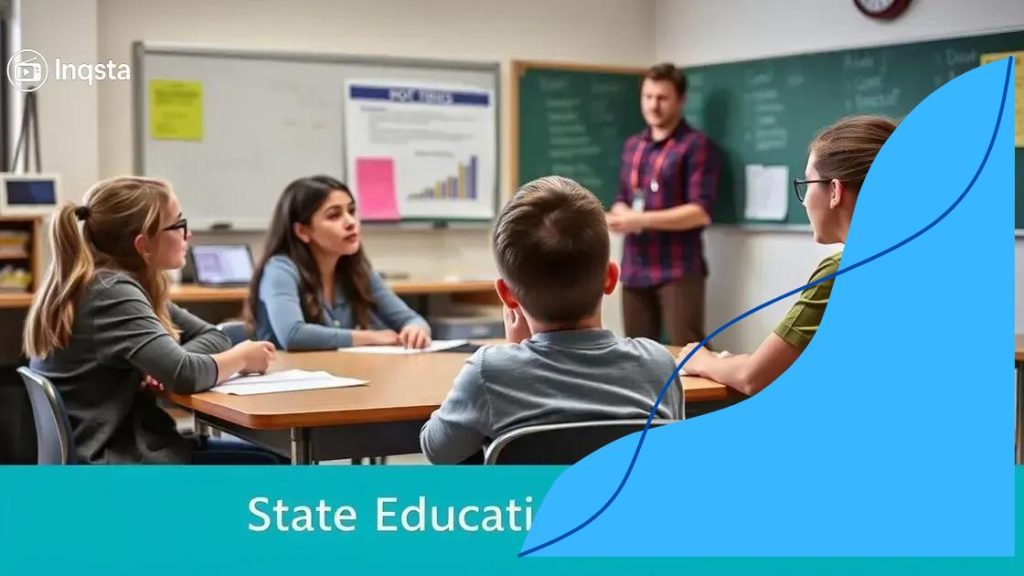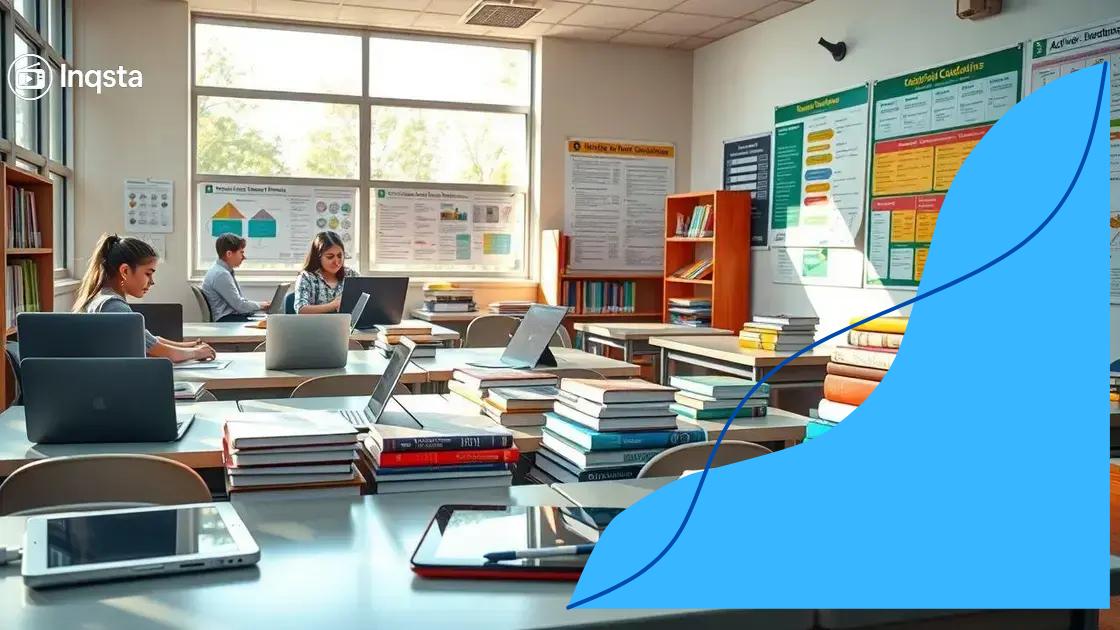State control over education policy: understanding its impact

Anúncios
State control over education policy determines curriculum, teacher responsibilities, and funding, significantly impacting how education is delivered and ensuring that all students have access to equitable learning opportunities.
State control over education policy influences not just what students learn but also how they learn. Have you ever considered the power dynamics at play in your schooling experience? Let’s dive into how these controls shape our educational landscape.
Anúncios
Understanding state control in education
To truly grasp state control in education, we must understand what it entails. This control often shapes the framework within which educational institutions operate, affecting everything from funding to curriculum. State policies can influence how teachers teach and how students learn.
Key Aspects of State Control
Several key elements illustrate the extent of state control:
- Curriculum Development: States set the standards and expectations for what students should learn every year. This impacts textbooks, teaching methods, and assessment strategies.
- Funding Allocation: Funding decisions are frequently made at the state level. This affects resources available to schools and can create disparities among districts.
- Regulatory Oversight: States develop regulations that schools must follow. This can range from safety protocols to grading policies.
The impact of state control extends to educators as well. Teachers often must align their lesson plans with state standards, which can limit their flexibility. This structure can create a tension; while standardization aims for uniform education quality, it may not cater to local community needs.
Anúncios
Examples of State Control in Action
Looking at specific examples can further clarify how state control operates. For instance, during the COVID-19 pandemic, states dictated school closures and online learning requirements. Such decisions showcased the government’s reach into educational operations.
Furthermore, teachers in some districts have had to adapt rapidly to changing state laws regarding educational content. This flexibility does not always enhance learning; instead, it can create confusion for both teachers and students.
In conclusion, understanding state control in education reveals the complex interactions between policy and practice.
Historical context of education policy
Understanding the historical context of education policy is crucial for grasping its present shape. Education has always been influenced by social, political, and economic factors. Over the centuries, policies have evolved to reflect changing societal needs and values.
Key Historical Milestones
Several key milestones have shaped education policy:
- The Land Ordinance of 1785: This established guidelines for surveying land and funding education in the newly formed United States.
- The Smith-Hughes Act of 1917: This act promoted vocational education, offering federal funding to states to support career and technical training.
- Brown v. Board of Education (1954): A landmark Supreme Court case that declared racial segregation in public schools unconstitutional, pushing for educational equity.
These milestones demonstrate the changing priorities in education. The importance of inclusive education has grown significantly. The civil rights movement propelled significant reforms that aimed to dismantle racial barriers in education.
Impacts of Historical Events
Historical events can greatly affect education policy. For instance, the launch of the Sputnik satellite in 1957 led to increased funding for science and technology education in the U.S. This event influenced the way students were taught and what subjects were prioritized.
Moreover, the evolution of federal policies through initiatives such as No Child Left Behind has aimed to ensure accountability in schools and quality education for all students. While these policies have their benefits, they also face criticism regarding their effectiveness and implementation.
Looking back at the historical context helps us see how past values and necessities influence today’s educational frameworks. Each policy created represents a response to the pressing needs of its time, shaping what students learn and how they learn it today.
Impact on curriculum development

The impact on curriculum development under state control is quite significant. Curriculum reflects both educational goals and state standards. As states set policies, they influence what students learn and how teachers deliver instruction.
Key Factors Influencing Curriculum
Several factors come into play regarding how state control shapes the curriculum:
- Standardized Testing: States often establish testing requirements that dictate what must be taught, aligning curriculum to ensure students perform well.
- Funding Sources: State funding can determine available resources for different subjects, thereby affecting curriculum choices.
- Societal Needs: Changes in societal expectations, such as the demand for STEM education, push states to adapt their curriculum accordingly.
This dynamic means that curriculum developers must remain aware of state guidelines while also considering the needs of local communities. For instance, with the rise of technology, many state curriculums now include coding and digital literacy.
Curriculum Flexibility and Challenges
While state control aims for consistency, it may limit flexibility in curriculum design. Teachers often have to teach within defined parameters set by state policies, which can stifle creativity in lesson planning. This restriction can lead to a lack of engagement for both students and teachers.
Moreover, balancing state standards with local relevance poses challenges. Some communities might prioritize different subjects based on their unique needs or cultural backgrounds. Adapting the curriculum to reflect these differences while adhering to state requirements is a delicate task.
Ultimately, the influence of state control on curriculum development shapes the educational experience, determining what knowledge and skills students acquire. These choices profoundly impact their readiness for future challenges.
Role of educators under state control
The role of educators under state control is multifaceted and significant. Teachers are often seen as the frontline implementers of state education policies. They must navigate the balance between adhering to state standards and addressing the unique needs of their students.
Responsibilities of Educators
Educators are responsible for several key areas:
- Curriculum Implementation: Teachers must follow the curriculum set by the state while trying to make it relevant and engaging for their students.
- Assessment Preparation: They prepare students for state-mandated assessments, which can dictate funding and school rankings.
- Classroom Management: Educators are also tasked with maintaining a learning environment that aligns with state regulations on discipline and safety.
While teachers try to inspire and engage their students, they also feel pressure from statewide mandates. This pressure can create a sense of restriction, limiting how educators can express their teaching styles. For example, they may have to teach to the test, which can hinder creativity in lesson plans.
Challenges Faced by Educators
The challenges of working under state control can be overwhelming. For instance, frequent changes in policies can lead to educators feeling unprepared. New standards and testing requirements can shift how subjects are taught and assessed.
Further complicating their roles, teachers often face varying degrees of support from their schools and districts. Some educators may have access to resources and professional development, while others do not, creating disparities in teaching quality.
By understanding the role of educators in a state-controlled system, we can appreciate the complexity of their tasks and the hard work they put into meeting both state requirements and student needs.
Future trends in education policy
Examining future trends in education policy reveals how changes in society, technology, and mindset can reshape classrooms. As we progress, multiple factors will influence how education is delivered and experienced.
Technological Integration
One major trend is the increased integration of technology in education. Online learning platforms, virtual classrooms, and educational apps are becoming more prevalent. This shift allows for personalized learning experiences, where students can learn at their own pace.
- Blended Learning: Combining traditional classroom methods with online instruction can cater to different learning styles.
- Data-Driven Decisions: Educators will increasingly use data analytics to identify student needs and improve educational outcomes.
- Access to Resources: Technology enables students from various backgrounds to access a wealth of educational resources that were previously unavailable.
As technology advances, schools must adapt to ensure that teachers and students are equipped with the necessary skills to thrive in a digital world.
Focus on Equity and Inclusion
Another trend shaping the future of education policy is a heightened focus on equity and inclusion. More attention is being given to providing equal educational opportunities for all students. This includes addressing disparities in funding, resources, and support.
Policy changes may require schools to implement programs that specifically support underrepresented or disadvantaged groups. Educators will need to develop culturally responsive pedagogy to better connect with diverse student populations.
Moreover, mental health awareness in schools is on the rise. Schools may incorporate mental health resources into their policies, ensuring that students receive comprehensive support.
These future trends indicate a shift towards a more inclusive and adaptable educational landscape. Educators, policymakers, and communities must prepare for these changes to ensure success for all students.
In conclusion, the landscape of education is evolving rapidly due to state control over policies. Understanding how this control affects educators, students, and curriculum is vital. With ongoing changes in technology and a commitment to equity, the future of education holds promise. Educators must adapt to these trends, ensuring that all students receive quality education. By staying informed and flexible, we can create learning environments that meet the needs of today and tomorrow.
FAQ – Frequently Asked Questions about State Control over Education Policy
What is state control over education policy?
State control over education policy refers to the authority of state governments to set regulations, standards, and funding for public education.
How does state control affect teachers?
State control impacts teachers by dictating curriculum, assessment methods, and teaching standards, which can limit their flexibility in the classroom.
What future trends are emerging in education policy?
Future trends in education policy include increased technological integration, a focus on equity and inclusion, and the adaptation of teaching methods to meet diverse student needs.
Why is equity important in education?
Equity in education ensures that all students have access to the same quality of education, resources, and opportunities, regardless of their background.